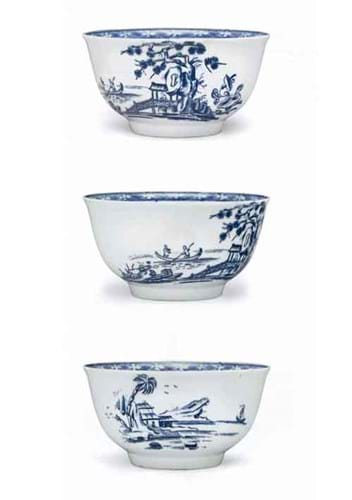
But there was another story to be told.
For years, scholars had been aware that an enigmatic Staffordshire potter, John Bartlam, had emigrated to South Carolina around 1763 in the hope of mining the abundant raw materials found in the region (china clays had first been used by Andrew Duché in Savannah in the 1730s) and satisfy the desire of colonial America to dine in the English style.
His factory was based first in Cain Hoy, on the Wando river near Charleston, from 1765, and then in the port city itself from 1770 until 1773 when Bartlam returned to England.
But exactly what he had made in South Carolina was mere speculation until the Cain Hoy site was located in 2007. There a team of archaeologists from the South Carolina Institute of Archaeology recovered not just fragments of press-moulded creamware (the subject of an article in the Journal of Early Southern Decorative Arts as early as 1991), but also sherds of translucent soft-paste porcelain.
Of particular interest were the fragmentary wasters of three blue-decorated teabowls, each painted to the rim with a diaper pattern and transfer-printed with vignettes previously unknown on extant English examples.
The potting was 'provincial' but Bartlam, or one of his workmen, was clearly well versed in the art of engraving a copperplate. Combining typical chinoiserie motifs with a rendering of a palmetto to the interior (a nod to a well-known South Carolina symbol?), the design was quickly dubbed the Bartlam on the Wando pattern.
The findings knocked into a cocked hat the notion that the 19 pieces of porcelain surviving from the American China Manufactory were the first produced on the continent (in fact it emerged Bonnin and Morris had taken adverts in the Charleston press in the hope of head-hunting Bartlam's employees). But had any finished vessels survived?
Bartlam Discovery
In 2010, the London-based English porcelain specialist Roderick Jellicoe spotted an intact Bartlam teabowl in a British collection - identifying it from the distinctive transfer-printed decoration found on sherds at Cain Hoy.
In April 2010, after scientific and visual analysis confirmed the discovery, he sold it to the Chipstone Foundation in Milwaukee. Shortly afterwards ceramics historian Robert Hunter penned an article in The Magazine Antiques in January/February 2011.
"This newly-discovered 18th century teabowl, a modest object by any measure, represents the earliest intact example of American-made porcelain," he wrote. "Its discovery reflects the dynamic nature of decorative arts scholarship, where the next turn of the spade or opening of a forgotten drawer might bring a piece of the past back to life."
Hunter hoped that more Cain Hoy porcelain might emerge on the market and, indeed, one teabowl soon became four. Again Britain was the source.
The publication of the new discovery on the Chipstone's website was doubtless of interest to the various UK private collectors who had bought three idiosyncratic teabowls from Jupiter Antiques of East Sussex in 2004.
At the time they were sold as Isleworth (the short-lived London factory that itself only arrived on the collecting map in the late 1990s), but their reattribution moved them into an altogether different collecting sphere… and an altogether different financial league too.
While none of the bowls was in perfect condition, one was sold to the Philadelphia Museum of Art last autumn for $75,000, while another now resides in a private collection. The third - described as 'the property of an English collector' - was offered for sale by Christie's New York as part of their Americana sale on January 25 with an estimate of $30,000-50,000. There it sold at $120,000 (£76,000) - or $146,500 including buyer's premium - to a buyer who wishes to remain anonymous.
Quite why all four examples of Cain Hoy porcelain were found in Britain is a matter for conjecture, but perhaps Bartlam was shipping his porcelain to Britain for sale or had returned home with some of his stock.
Many questions remain regarding these survivors from the embryonic years of American porcelain production. Above all - are there more out there?




